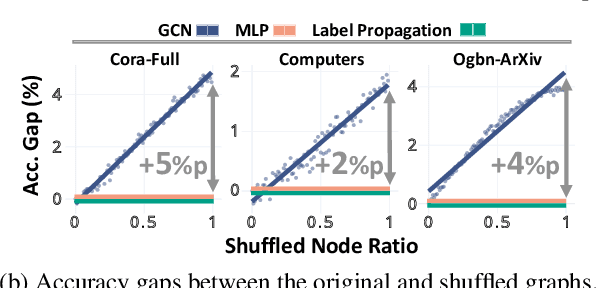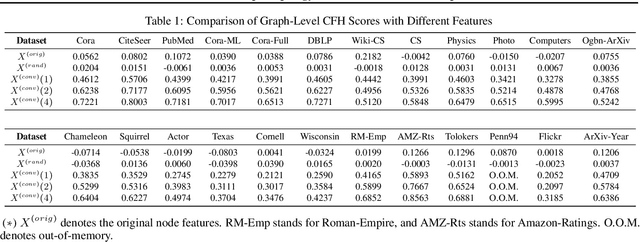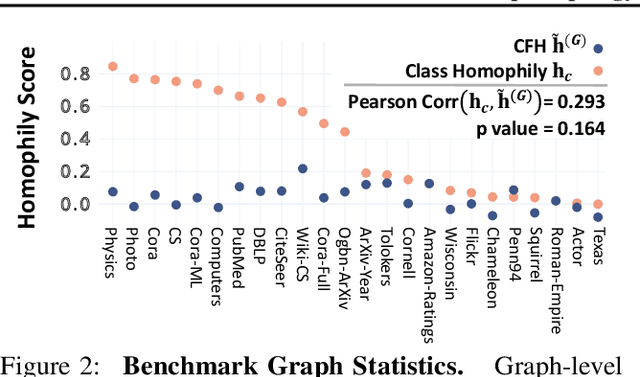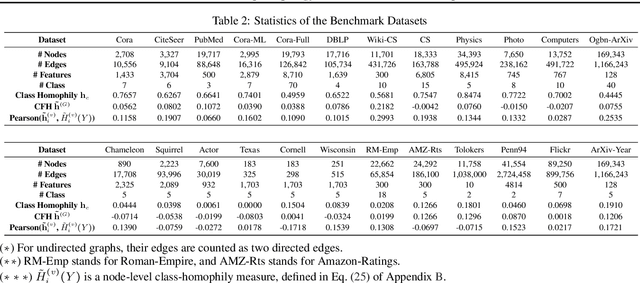Jaemin Yoo
'Hello, World!': Making GNNs Talk with LLMs
May 27, 2025Abstract:While graph neural networks (GNNs) have shown remarkable performance across diverse graph-related tasks, their high-dimensional hidden representations render them black boxes. In this work, we propose Graph Lingual Network (GLN), a GNN built on large language models (LLMs), with hidden representations in the form of human-readable text. Through careful prompt design, GLN incorporates not only the message passing module of GNNs but also advanced GNN techniques, including graph attention and initial residual connection. The comprehensibility of GLN's hidden representations enables an intuitive analysis of how node representations change (1) across layers and (2) under advanced GNN techniques, shedding light on the inner workings of GNNs. Furthermore, we demonstrate that GLN achieves strong zero-shot performance on node classification and link prediction, outperforming existing LLM-based baseline methods.
Aggregation Buffer: Revisiting DropEdge with a New Parameter Block
May 27, 2025Abstract:We revisit DropEdge, a data augmentation technique for GNNs which randomly removes edges to expose diverse graph structures during training. While being a promising approach to effectively reduce overfitting on specific connections in the graph, we observe that its potential performance gain in supervised learning tasks is significantly limited. To understand why, we provide a theoretical analysis showing that the limited performance of DropEdge comes from the fundamental limitation that exists in many GNN architectures. Based on this analysis, we propose Aggregation Buffer, a parameter block specifically designed to improve the robustness of GNNs by addressing the limitation of DropEdge. Our method is compatible with any GNN model, and shows consistent performance improvements on multiple datasets. Moreover, our method effectively addresses well-known problems such as degree bias or structural disparity as a unifying solution. Code and datasets are available at https://github.com/dooho00/agg-buffer.
Emergence of psychopathological computations in large language models
Apr 10, 2025Abstract:Can large language models (LLMs) implement computations of psychopathology? An effective approach to the question hinges on addressing two factors. First, for conceptual validity, we require a general and computational account of psychopathology that is applicable to computational entities without biological embodiment or subjective experience. Second, mechanisms underlying LLM behaviors need to be studied for better methodological validity. Thus, we establish a computational-theoretical framework to provide an account of psychopathology applicable to LLMs. To ground the theory for empirical analysis, we also propose a novel mechanistic interpretability method alongside a tailored empirical analytic framework. Based on the frameworks, we conduct experiments demonstrating three key claims: first, that distinct dysfunctional and problematic representational states are implemented in LLMs; second, that their activations can spread and self-sustain to trap LLMs; and third, that dynamic, cyclic structural causal models encoded in the LLMs underpin these patterns. In concert, the empirical results corroborate our hypothesis that network-theoretic computations of psychopathology have already emerged in LLMs. This suggests that certain LLM behaviors mirroring psychopathology may not be a superficial mimicry but a feature of their internal processing. Thus, our work alludes to the possibility of AI systems with psychopathological behaviors in the near future.
Criteria-Aware Graph Filtering: Extremely Fast Yet Accurate Multi-Criteria Recommendation
Feb 13, 2025Abstract:Multi-criteria (MC) recommender systems, which utilize MC rating information for recommendation, are increasingly widespread in various e-commerce domains. However, the MC recommendation using training-based collaborative filtering, requiring consideration of multiple ratings compared to single-criterion counterparts, often poses practical challenges in achieving state-of-the-art performance along with scalable model training. To solve this problem, we propose CA-GF, a training-free MC recommendation method, which is built upon criteria-aware graph filtering for efficient yet accurate MC recommendations. Specifically, first, we construct an item-item similarity graph using an MC user-expansion graph. Next, we design CA-GF composed of the following key components, including 1) criterion-specific graph filtering where the optimal filter for each criterion is found using various types of polynomial low-pass filters and 2) criteria preference-infused aggregation where the smoothed signals from each criterion are aggregated. We demonstrate that CA-GF is (a) efficient: providing the computational efficiency, offering the extremely fast runtime of less than 0.2 seconds even on the largest benchmark dataset, (b) accurate: outperforming benchmark MC recommendation methods, achieving substantial accuracy gains up to 24% compared to the best competitor, and (c) interpretable: providing interpretations for the contribution of each criterion to the model prediction based on visualizations.
Political-LLM: Large Language Models in Political Science
Dec 09, 2024



Abstract:In recent years, large language models (LLMs) have been widely adopted in political science tasks such as election prediction, sentiment analysis, policy impact assessment, and misinformation detection. Meanwhile, the need to systematically understand how LLMs can further revolutionize the field also becomes urgent. In this work, we--a multidisciplinary team of researchers spanning computer science and political science--present the first principled framework termed Political-LLM to advance the comprehensive understanding of integrating LLMs into computational political science. Specifically, we first introduce a fundamental taxonomy classifying the existing explorations into two perspectives: political science and computational methodologies. In particular, from the political science perspective, we highlight the role of LLMs in automating predictive and generative tasks, simulating behavior dynamics, and improving causal inference through tools like counterfactual generation; from a computational perspective, we introduce advancements in data preparation, fine-tuning, and evaluation methods for LLMs that are tailored to political contexts. We identify key challenges and future directions, emphasizing the development of domain-specific datasets, addressing issues of bias and fairness, incorporating human expertise, and redefining evaluation criteria to align with the unique requirements of computational political science. Political-LLM seeks to serve as a guidebook for researchers to foster an informed, ethical, and impactful use of Artificial Intelligence in political science. Our online resource is available at: http://political-llm.org/.
Rethinking Reconstruction-based Graph-Level Anomaly Detection: Limitations and a Simple Remedy
Oct 27, 2024Abstract:Graph autoencoders (Graph-AEs) learn representations of given graphs by aiming to accurately reconstruct them. A notable application of Graph-AEs is graph-level anomaly detection (GLAD), whose objective is to identify graphs with anomalous topological structures and/or node features compared to the majority of the graph population. Graph-AEs for GLAD regard a graph with a high mean reconstruction error (i.e. mean of errors from all node pairs and/or nodes) as anomalies. Namely, the methods rest on the assumption that they would better reconstruct graphs with similar characteristics to the majority. We, however, report non-trivial counter-examples, a phenomenon we call reconstruction flip, and highlight the limitations of the existing Graph-AE-based GLAD methods. Specifically, we empirically and theoretically investigate when this assumption holds and when it fails. Through our analyses, we further argue that, while the reconstruction errors for a given graph are effective features for GLAD, leveraging the multifaceted summaries of the reconstruction errors, beyond just mean, can further strengthen the features. Thus, we propose a novel and simple GLAD method, named MUSE. The key innovation of MUSE involves taking multifaceted summaries of reconstruction errors as graph features for GLAD. This surprisingly simple method obtains SOTA performance in GLAD, performing best overall among 14 methods across 10 datasets.
End-To-End Self-tuning Self-supervised Time Series Anomaly Detection
Apr 03, 2024



Abstract:Time series anomaly detection (TSAD) finds many applications such as monitoring environmental sensors, industry KPIs, patient biomarkers, etc. A two-fold challenge for TSAD is a versatile and unsupervised model that can detect various different types of time series anomalies (spikes, discontinuities, trend shifts, etc.) without any labeled data. Modern neural networks have outstanding ability in modeling complex time series. Self-supervised models in particular tackle unsupervised TSAD by transforming the input via various augmentations to create pseudo anomalies for training. However, their performance is sensitive to the choice of augmentation, which is hard to choose in practice, while there exists no effort in the literature on data augmentation tuning for TSAD without labels. Our work aims to fill this gap. We introduce TSAP for TSA "on autoPilot", which can (self-)tune augmentation hyperparameters end-to-end. It stands on two key components: a differentiable augmentation architecture and an unsupervised validation loss to effectively assess the alignment between augmentation type and anomaly type. Case studies show TSAP's ability to effectively select the (discrete) augmentation type and associated (continuous) hyperparameters. In turn, it outperforms established baselines, including SOTA self-supervised models, on diverse TSAD tasks exhibiting different anomaly types.
HypeBoy: Generative Self-Supervised Representation Learning on Hypergraphs
Mar 31, 2024



Abstract:Hypergraphs are marked by complex topology, expressing higher-order interactions among multiple nodes with hyperedges, and better capturing the topology is essential for effective representation learning. Recent advances in generative self-supervised learning (SSL) suggest that hypergraph neural networks learned from generative self supervision have the potential to effectively encode the complex hypergraph topology. Designing a generative SSL strategy for hypergraphs, however, is not straightforward. Questions remain with regard to its generative SSL task, connection to downstream tasks, and empirical properties of learned representations. In light of the promises and challenges, we propose a novel generative SSL strategy for hypergraphs. We first formulate a generative SSL task on hypergraphs, hyperedge filling, and highlight its theoretical connection to node classification. Based on the generative SSL task, we propose a hypergraph SSL method, HypeBoy. HypeBoy learns effective general-purpose hypergraph representations, outperforming 16 baseline methods across 11 benchmark datasets.
Feature Distribution on Graph Topology Mediates the Effect of Graph Convolution: Homophily Perspective
Feb 07, 2024



Abstract:How would randomly shuffling feature vectors among nodes from the same class affect graph neural networks (GNNs)? The feature shuffle, intuitively, perturbs the dependence between graph topology and features (A-X dependence) for GNNs to learn from. Surprisingly, we observe a consistent and significant improvement in GNN performance following the feature shuffle. Having overlooked the impact of A-X dependence on GNNs, the prior literature does not provide a satisfactory understanding of the phenomenon. Thus, we raise two research questions. First, how should A-X dependence be measured, while controlling for potential confounds? Second, how does A-X dependence affect GNNs? In response, we (i) propose a principled measure for A-X dependence, (ii) design a random graph model that controls A-X dependence, (iii) establish a theory on how A-X dependence relates to graph convolution, and (iv) present empirical analysis on real-world graphs that aligns with the theory. We conclude that A-X dependence mediates the effect of graph convolution, such that smaller dependence improves GNN-based node classification.
Self-Supervision for Tackling Unsupervised Anomaly Detection: Pitfalls and Opportunities
Aug 28, 2023Abstract:Self-supervised learning (SSL) is a growing torrent that has recently transformed machine learning and its many real world applications, by learning on massive amounts of unlabeled data via self-generated supervisory signals. Unsupervised anomaly detection (AD) has also capitalized on SSL, by self-generating pseudo-anomalies through various data augmentation functions or external data exposure. In this vision paper, we first underline the importance of the choice of SSL strategies on AD performance, by presenting evidences and studies from the AD literature. Equipped with the understanding that SSL incurs various hyperparameters (HPs) to carefully tune, we present recent developments on unsupervised model selection and augmentation tuning for SSL-based AD. We then highlight emerging challenges and future opportunities; on designing new pretext tasks and augmentation functions for different data modalities, creating novel model selection solutions for systematically tuning the SSL HPs, as well as on capitalizing on the potential of pretrained foundation models on AD through effective density estimation.
 Add to Chrome
Add to Chrome Add to Firefox
Add to Firefox Add to Edge
Add to Edge